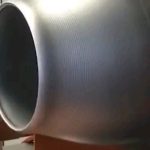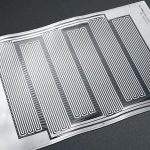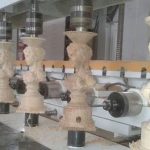High-temperature alloy is an engineering material used at temperatures around 1000°C. It is widely used in aerospace, aviation, and various heat treatment equipment. Since high-temperature alloys contain many high-melting-point alloy elements such as Fe, Ti, Cr, Ni, V, W, Mo, etc., these alloy elements and other alloy elements form austenitic alloys with high purity and dense structure. Moreover, some elements combine with non-metallic elements C, B, N, etc. to form metal and non-metallic compounds with high hardness, low specific gravity and high melting point, making the cutting processability very poor. Its relative machinability is only 5 to 20% of that of No. 45 steel.
CNC Machining High Temperature Alloy
Cutting Characteristics
- a. High cutting force: 2 to 3 times greater than cutting No. 45 steel.
- b. High cutting temperature: about 50% higher than cutting No. 45 steel.
- c. Severe work hardening: the hardness of the machined surface and the machined surface when cutting it is 50 to 100% higher than the base body.
- d. Tools are prone to wear: they are prone to bonding, diffusion, oxidation and groove wear during cutting.
Tool Material
- a. High-speed steel: High-vanadium, high-carbon, and aluminum-containing high-speed steel should be used.
- b. Carbide: YG type carbide should be used. It is best to use fine-grained and ultra-fine-grained cemented carbide containing TaC or NbC. Such as YG8, YG6X, YG10H, YW4, YD15, YGRM, YS2, 643, 813, 712, 726, etc.
- c. Ceramics: When cutting cast high-temperature alloys, the use of ceramic tools also has its unique advantages.
Tool Geometry Parameters
Deformed high-temperature alloys (such as forging, hot rolling, cold drawing). The rake angle γ0 of the tool is about 10°; the γ0 of cast high-temperature alloy is about 0°, and negative chamfering is generally not required. The tool clearance angle is generally α=10°~15°. The tool inclination angle λs is -5°~-10° during rough machining, and λs =O~3° during finishing. The main deflection angle κr is 45°~75°. The tool tip arc radius r is 0.5~2mm. When roughing, take the larger value.
Cutting Amount
a. High-speed steel cutting tools: The cutting speed Vc for cutting cast high-temperature alloys is about 3m/min, and the cutting speed for cutting deformed high-temperature alloys Vc=5~10m/min.
b. Carbide cutting tools: cutting deformed high-temperature alloy Vc: 40~60m/min; cutting cast high-temperature alloy Vc=7~10m/min. Both the feed f and the cutting depth αp should be greater than 0.1mm to prevent the tool from cutting on the hardened surface and aggravating tool wear.
Cutting Fluid
During rough machining, emulsion and extreme pressure emulsion are used. For finishing, use extreme pressure emulsion or extreme pressure cutting oil. When reaming, use 85-90% vulcanized oil + 10-15% kerosene, or vulcanized oil (or lard) + CCl4. It is very difficult to tap high-temperature alloys. In addition to appropriately increasing the diameter of the bottom hole, white lead oil + machine oil should be used, or chlorinated paraffin should be diluted with kerosene, or MoS2 ointment should be used.
High Temperature Alloy Drilling
Drilling high-temperature alloys is very difficult. Carbide drill bits should generally be used, such as shallow hole drills, solid or welded carbide drill bits. If a high-speed steel drill bit is used, the secondary clearance angle α’0 of the drill bit should be ground to reduce friction with the hole wall. At the same time, the drill tip should also be ground to reduce the width of the drill chisel edge to reduce the axial force during drilling. The drill bit must be sharp, and it is best to use automatic feed. When drilling, the drill bit should not stay on the cutting surface to avoid aggravating the hardening of the cutting surface and causing difficulty in the next feed.






